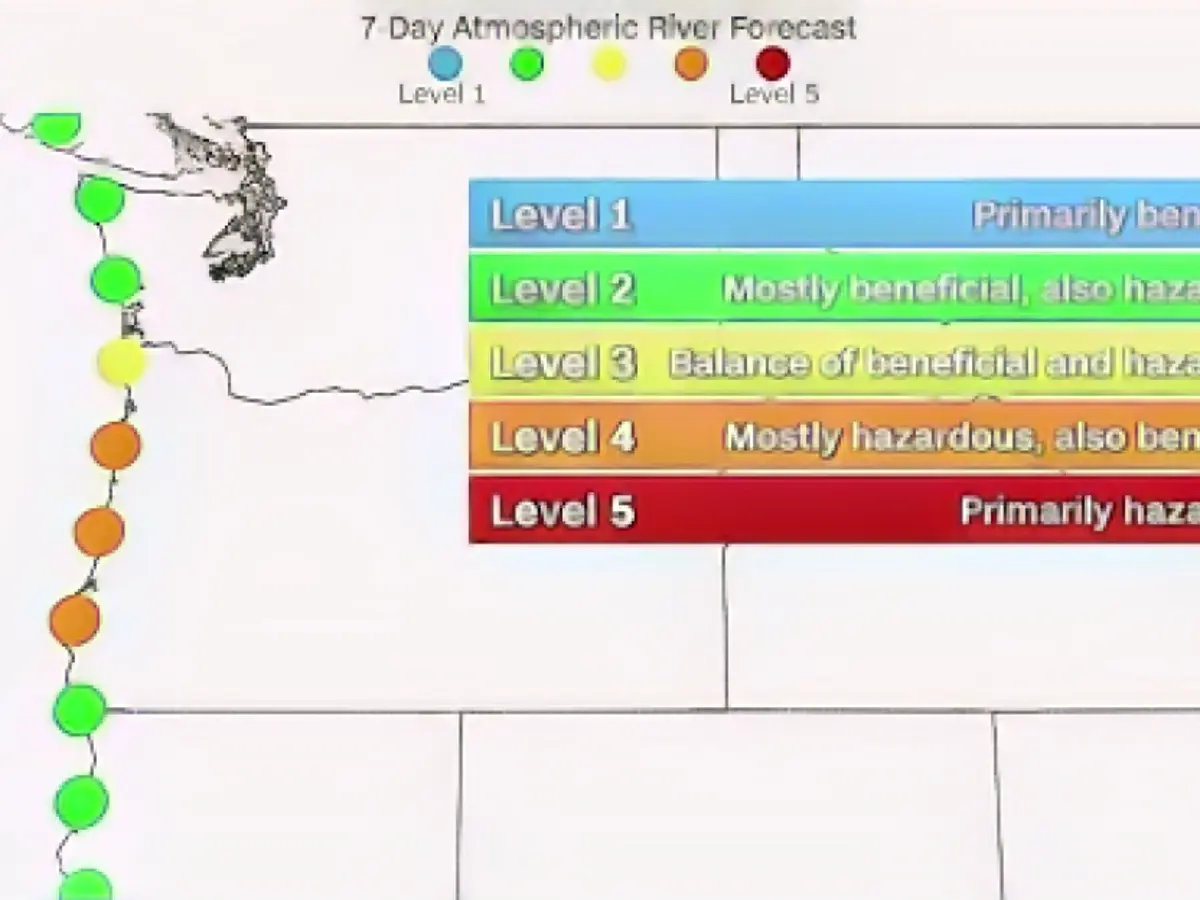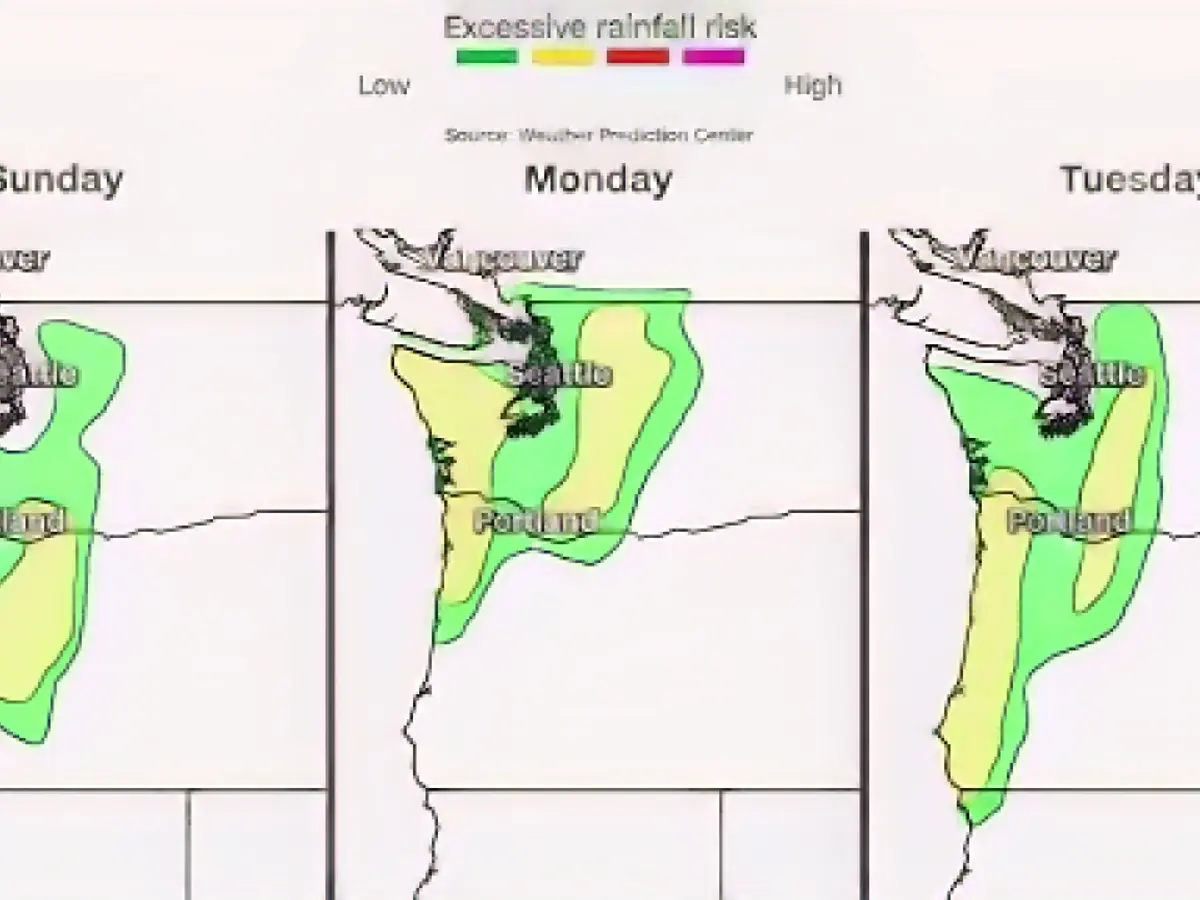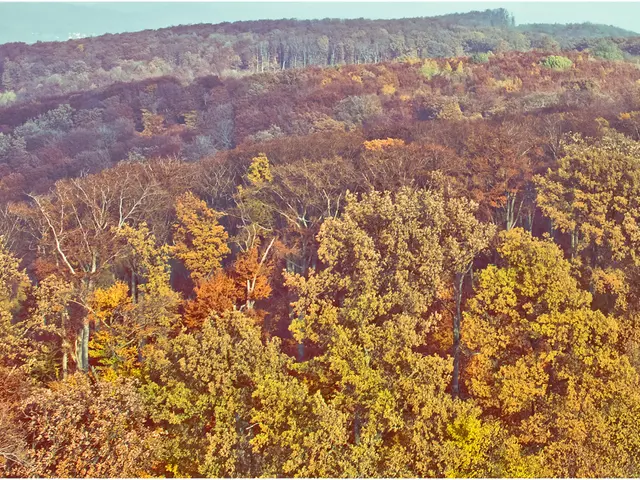Flood-inducing atmospheric rivers loom over the northwest US, promising heavy rain and snow
By now, over half a dozen western states were under a winter weather advisory on Sunday, as atmospheric rivers (ARs) expanded from Washington and Oregon towards Colorado and Wyoming.
These atmospheric rivers are moisture streams that help transport saturated air from the tropics to higher latitudes, providing a steady supply of rain or snow.
According to the Weather Prediction Center, the Winter Storm Severity Index (WSSI) suggests that the peaks of the Pacific Northwest and the Rocky Mountains will likely face considerable ramifications, potentially leading to hazardous or even inaccessible travel conditions in affected areas.
In coastal regions of Oregon, Washington, and northwestern California, forecasts predict 5-10 inches of rainfall within the next couple of days. In the mountainous regions, they anticipate 1-3 feet of snowfall.
Oregon and Washington issued avalanche warnings for various passes, including Stevens and Snoqualmie Pass in Washington, and the South Cascades in Washington. The Northwest Avalanche Center in Seattle warned that within the next 24 hours, dangerous avalanche conditions would develop, urging against travel in avalanche-prone areas.
This sequence of atmospheric rivers, referred to as an AR Series, will begin on Saturday and continue through the region until midweek, with little rest between systems. Inadequate recuperation periods increase the likelihood of flooding risks.
Chad Heck, a research and operational meteorologist at the US Weather Service's UC San Diego Western Weather and Water Extremes Center, explained that in situations where multiple atmospheric rivers converge inland, the hydrological consequences are strengthened since waterways and soils have insufficient time to return to their baseline levels.
An AR event of category 4 out of 5 is anticipated to impact the entire Oregon coast.

Not all atmospheric river events are negative. In fact, events with ratings of 1 and 2 are primarily seen as beneficial rainfall and are greatly needed in the Western US to address depleted water levels. However, AR events classified as 4 and 5 cause more harm than good, as the risks associated with flooding and travel hazards surpass the benefits.
"Given the anticipated heavy rains, the soil will become more sensitive, allowing for larger runoffs and flood risks," said the Weather Prediction Center. "Initially, heavy snowfall is expected, and it may be possible at the west-facing slopes of the Cascades." It may ultimately lead to some damage, with additional flood risks from melting snow.
As a result of the anticipated excessive rainfall, portions of western Oregon and Washington face a moderate flood risk (Level 2 out of 4) on Sunday, Monday, and Tuesday.
Strong winds with sustained speeds of up to 80 mph can also topple trees and power lines.
Read also:
In this article's context, here are two sentences containing the word 'us':
The Weather Prediction Center warned: "The Winter Storm Severity Index (WSSI) indicates that the highest elevations of the Pacific Northwest and the Rocky Mountains are likely to experience significant impacts, which may lead to dangerous or even impassable travel conditions in these affected areas."
Due to anticipated heavy rains and potential mudslides, authorities urge residents and travelers in affected regions to stay indoors and refrain from non-essential travel.
Source:
Enrichment Insights
- Impact Analysis: Heavy rains and floods pose a significant risk to vulnerable areas, like burn-scarred regions in Southern California, where the absence of vegetation hinders water absorption, elevating runoff potential.
- Microscale Weather Forecasting: Accurate weather predictions on a city- and neighborhood-scale aide in the preparation and mitigation of hazards associated with atmospheric river events, such as the potential for flash flooding and landslides.
- Water Resource Management: Accurate rainfall forecasts help cities and water utilities manage water resources, ensuring the fulfillment of drinking water, irrigation, and flood control needs.
- Disaster Response and Recovery: Anticipating the environmental impacts of atmospheric river events allows for swift containment efforts and recovery planning, mitigating long-term damage.
- Climate Change and Atmospheric River Events: As temperatures continue to rise due to climate change, it can exacerbate both the frequency and severity of atmospheric river events, impacting communities and ecosystems across the Western United States.








